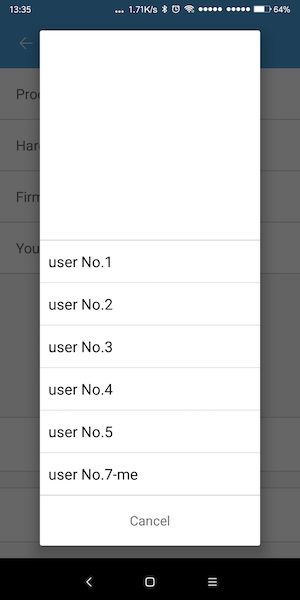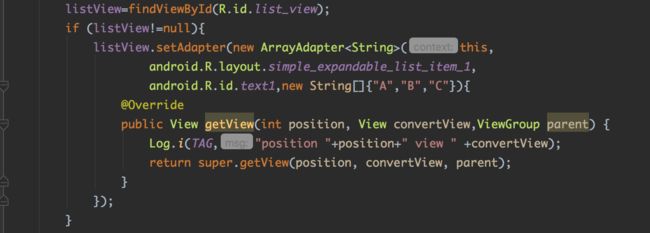由Dialog里面嵌套ListView之后的高度自适应引起的ListView性能优化
前言
随着RecyclerView的普及,ListView差不多是安卓快要淘汰的控件了,但是我们有时候还是会用到,基本上可以说是前些年最常用的Android控件之一了.抛开我们的主题,我们先来谈谈ListView的一些小小的细节,可能是很多开发者在开发过程中并没有注意到的细节,这些细节设置会影响到我们的App的性能.
- android:layout_height属性
我们在使用ListView的时候很可能随手就会写一个layout_height=”wrap_content”或者layout_height=”match_parent”,非常非常普通,咋一看,我写的没错啊…可是实际上layout_height=”wrap_content” 是错误的写法!!!会严重影响程序的性能 我们先来做一个实验:
xml布局文件如下
<LinearLayout xmlns:android="http://schemas.android.com/apk/res/android"
android:layout_width="match_parent"
android:layout_height="match_parent">
<ListView
android:id="@+id/list_view"
android:layout_width="match_parent"
android:layout_height="wrap_content"
>ListView>
LinearLayout>
我们会发现getView总共被调用了15次!其中4次是null的,11次为重复调用,ListView的item数目只有3项!!!太可怕了
我们试着将ListView的高度属性改为layout_height=”match_parent”,然后看看
![]()
我们可以看到getView()只被调用了3次!这应该是我们期望的结果!
原因分析:
了解原因前,我们应该先了解View的绘制流程,之前我的博客没有关于View绘制流程的介绍,那么在这边说一下,是一个很重要的知识点.
View的绘制流程是通过 onMeasure()->onLayout()->onDraw()
onMeasure() :主要工作是测量视图的大小.从顶层的父View到子View递归调用measure方法,measure方法又回调onMeasure().
onLayout: 主要工作是确定View的位置,进行页面布局.从顶层的父View向子View的递归调用view.layout方法的过程,即父View根据上一步measure子view所得到的布局大小和布局参数,将子view放在合适的位置上
onDraw() 主要工作是绘制视图.ViewRoot创建一个Canvas对象,然后调用onDraw()方法.总共6个步骤.1.绘制视图背景,2.保存当前画布的图层(Layer),3.绘制View内容,4.绘制View的子View视图,没有的话就不绘制,5.还原图层,6.绘制滚动条.
了解了View的绘制流程,那么我们回到这个问题上.设置ListView的属性layout_height=”wrap_content”,就意味着Listview的高度由子View决定,当在onMeasure()的时候,需要测量子View的高度,那我们来看看Listview的onMeasure()方法.
@Override
protected void onMeasure(int widthMeasureSpec, int heightMeasureSpec) {
// Sets up mListPadding
super.onMeasure(widthMeasureSpec, heightMeasureSpec);
int widthMode = MeasureSpec.getMode(widthMeasureSpec);
int heightMode = MeasureSpec.getMode(heightMeasureSpec);
int widthSize = MeasureSpec.getSize(widthMeasureSpec);
int heightSize = MeasureSpec.getSize(heightMeasureSpec);
int childWidth = 0;
int childHeight = 0;
int childState = 0;
mItemCount = mAdapter == null ? 0 : mAdapter.getCount();
if (mItemCount > 0 && (widthMode == MeasureSpec.UNSPECIFIED ||
heightMode == MeasureSpec.UNSPECIFIED)) {
final View child = obtainView(0, mIsScrap);
measureScrapChild(child, 0, widthMeasureSpec);
childWidth = child.getMeasuredWidth();
childHeight = child.getMeasuredHeight();
childState = combineMeasuredStates(childState, child.getMeasuredState());
if (recycleOnMeasure() && mRecycler.shouldRecycleViewType(
((LayoutParams) child.getLayoutParams()).viewType)) {
mRecycler.addScrapView(child, 0);
}
}
if (widthMode == MeasureSpec.UNSPECIFIED) {
widthSize = mListPadding.left + mListPadding.right + childWidth +
getVerticalScrollbarWidth();
} else {
widthSize |= (childState&MEASURED_STATE_MASK);
}
if (heightMode == MeasureSpec.UNSPECIFIED) {
heightSize = mListPadding.top + mListPadding.bottom + childHeight +
getVerticalFadingEdgeLength() * 2;
}
if (heightMode == MeasureSpec.AT_MOST) {
// TODO: after first layout we should maybe start at the first visible position, not 0
heightSize = measureHeightOfChildren(widthMeasureSpec, 0, NO_POSITION, heightSize, -1);
}
setMeasuredDimension(widthSize , heightSize);
mWidthMeasureSpec = widthMeasureSpec;
}其中
if (heightMode == MeasureSpec.AT_MOST) {
// TODO: after first layout we should maybe start at the first visible position, not 0
heightSize = measureHeightOfChildren(widthMeasureSpec, 0, NO_POSITION, heightSize, -1);
}比较重要
再看measureHeightOfChildren()
final int measureHeightOfChildren(int widthMeasureSpec, int startPosition, int endPosition,
final int maxHeight, int disallowPartialChildPosition) {
...
for (i = startPosition; i <= endPosition; ++i) {
child = obtainView(i, isScrap);
measureScrapChild(child, i, widthMeasureSpec);
...
// Recycle the view before we possibly return from the method
if (recyle && recycleBin.shouldRecycleViewType(
((LayoutParams) child.getLayoutParams()).viewType)) {
recycleBin.addScrapView(child, -1);
}
returnedHeight += child.getMeasuredHeight();
if (returnedHeight >= maxHeight) {
...
}
if ((disallowPartialChildPosition >= 0) && (i >= disallowPartialChildPosition)) {
...
}
}
return returnedHeight;
}obtainView(i, isScrap)是子View的实例
measureScrapChild(child, i, widthMeasureSpec); 测量子View
recycleBin.addScrapView(child, -1);将子View加入缓存,可以用来复用
if (returnedHeight >= maxHeight) {return ...;}如果已经测量的子View的高度大于maxHeight的话就直接return出循环,这样的做法也很好理解,其实是ListView很聪明的一种做法,你可以想想比如说这个屏幕只能画10个Item高度,你有20个Item,那么画出10个就行了,剩下的十个就没必要画了~
我们现在看下obtainView()方法
View obtainView(int position, boolean[] isScrap) {
Trace.traceBegin(Trace.TRACE_TAG_VIEW, "obtainView");
isScrap[0] = false;
// Check whether we have a transient state view. Attempt to re-bind the
// data and discard the view if we fail.
final View transientView = mRecycler.getTransientStateView(position);
if (transientView != null) {
final LayoutParams params = (LayoutParams) transientView.getLayoutParams();
// If the view type hasn't changed, attempt to re-bind the data.
if (params.viewType == mAdapter.getItemViewType(position)) {
final View updatedView = mAdapter.getView(position, transientView, this);
// If we failed to re-bind the data, scrap the obtained view.
if (updatedView != transientView) {
setItemViewLayoutParams(updatedView, position);
mRecycler.addScrapView(updatedView, position);
}
}
// Scrap view implies temporary detachment.
isScrap[0] = true;
return transientView;
}
final View scrapView = mRecycler.getScrapView(position);
final View child = mAdapter.getView(position, scrapView, this);
if (scrapView != null) {
if (child != scrapView) {
// Failed to re-bind the data, return scrap to the heap.
mRecycler.addScrapView(scrapView, position);
} else {
isScrap[0] = true;
child.dispatchFinishTemporaryDetach();
}
}
if (mCacheColorHint != 0) {
child.setDrawingCacheBackgroundColor(mCacheColorHint);
}
if (child.getImportantForAccessibility() == IMPORTANT_FOR_ACCESSIBILITY_AUTO) {
child.setImportantForAccessibility(IMPORTANT_FOR_ACCESSIBILITY_YES);
}
setItemViewLayoutParams(child, position);
if (AccessibilityManager.getInstance(mContext).isEnabled()) {
if (mAccessibilityDelegate == null) {
mAccessibilityDelegate = new ListItemAccessibilityDelegate();
}
if (child.getAccessibilityDelegate() == null) {
child.setAccessibilityDelegate(mAccessibilityDelegate);
}
}
Trace.traceEnd(Trace.TRACE_TAG_VIEW);
return child;
}得到一个视图,它显示的数据与指定的位置。这叫做当我们已经发现的观点不是可供重用的回收站。剩下的唯一的选择是将一个古老的视图或制作一个新的.
我们应该关注下以下两行代码:
...
final View scrapView = mRecycler.getScrapView(position);
final View child = mAdapter.getView(position, scrapView, this);
...这两行代码的意思就是说先从缓存里面取出来一个废弃的view,然后将当前的位置跟view作为参数传入到getView()方法中.这个废弃的,然后又作为参数的view就是convertView.
然后我们总结下刚刚的步骤:
A、测量第0项的时候,convertView肯定是null的 View scrapView = mRecycler.getScrapView(position)也是空的,所以我们在log上可以看到.
![]()
B、第0项测量结束,这个第0项的View就被加入到复用缓存当中了;
C、开始测量第1项,这时因为是有第0项的View缓存的,所以getView的参数convertView就是这个第0项的View缓存,然后重复B步骤添加到缓存,只不过这个View缓存还是第0项的View;
D、继续测量第2项,重复C。
所以前面说到onMeasure方法会导致getView调用,而一个View的onMeasure方法调用时机并不是由自身决定,而是由其父视图来决定。ListView放在FrameLayout和RelativeLayout中其onMeasure方法的调用次数是完全不同的。在RelativeLayout中oMeasure()方法调用会翻倍.
由于onMeasure方法会多次被调用,上述问题中是两次,其实完整的调用顺序是onMeasure - onLayout - onMeasure - onLayout - onDraw。
所以根据上面的结论我们可以得出,如果LitsView的android:layout_height属性设置为wrap_content将会引起getView的多次测量
现象
如上bug图…
产生的原因
ListView的高度设置成了android:layout_height属性设置为wrap_content
ListView的父类是RelativeLayout,RelativiLayout布局会使子布局View的Measure周期翻倍,有兴趣可以看下三大基础布局性能比较
解决办法
根据每个Item的高度,然后再根据Adapter的count来动态算高.
代码如下:
public class SetHeight {
public void setListViewHeightBasedOnChildren(ListView listView, android.widget.BaseAdapter adapter) {
if (adapter==null){
return;
}
int totalHeight = 0;
for (int i = 0; i < adapter.getCount(); i++) { // listAdapter.getCount()返回数据项的数目
View listItem = adapter.getView(i, null, listView);
listItem.measure(0, 0); // 计算子项View 的宽高
totalHeight += listItem.getMeasuredHeight(); // 统计所有子项的总高度
}
ViewGroup.LayoutParams params = listView.getLayoutParams();
params.height = totalHeight
+ (listView.getDividerHeight() * (adapter.getCount() - 1));
// listView.getDividerHeight()获取子项间分隔符占用的高度
// params.height最后得到整个ListView完整显示需要的高度
listView.setLayoutParams(params);
}
}
xml布局,注意要将ListView的父类设置为LinearLayout
<LinearLayout xmlns:android="http://schemas.android.com/apk/res/android"
android:layout_width="fill_parent"
android:layout_height="wrap_content"
android:orientation="vertical">
<LinearLayout
android:layout_width="fill_parent"
android:layout_height="wrap_content"
android:layout_above="@+id/txt_cancel"
android:orientation="vertical">
<View
android:layout_width="fill_parent"
android:layout_height="@dimen/y2"
android:background="#cccccc" />
<ListView
android:id="@+id/lv_remain_item"
android:layout_width="fill_parent"
android:layout_height="0dp"
android:cacheColorHint="#00000000"
>ListView>
<View
android:layout_width="fill_parent"
android:layout_height="@dimen/y2"
android:background="#cccccc" />
LinearLayout>
<LinearLayout
android:layout_width="match_parent"
android:layout_height="wrap_content"
android:gravity="center"
android:orientation="horizontal"
>
<TextView
android:id="@+id/txt_cancel"
android:layout_width="fill_parent"
android:layout_height="@dimen/y120"
android:layout_alignParentBottom="true"
android:gravity="center"
android:text="cancel"
android:textSize="@dimen/x32" />
LinearLayout>
LinearLayout>然后在Listview使用处,调用该方法.
userListDialog.getmListView().setAdapter(scaleUserAdapter);
SetHeight.setListViewHeightBasedOnChildren(userListDialog.getmListView(),scaleUserAdapter);



